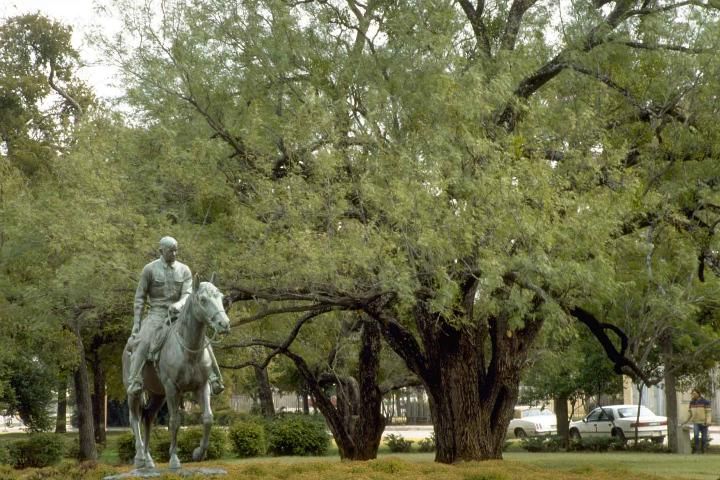Introduction
This North American native tree reaches 30 feet in height and forms a rounded canopy with many drooping, crooked branches emanating low on the trunk. These branches are armed with one-inch-long spines which can cause much damage to flesh, but thornless selections are available from nurseries. Mesquite has a tendency to form thickets and these thorns help make the dense growth impenetrable. The reddish-brown bark is rough and fissured. The root system of Mesquite is quite extensive and will spread far and wide to consume whatever moisture is available, sometimes to the detriment of other plantings near the tree. Mesquite is considered a weed along the Rio Grande and in other areas in Texas where it will easily invade adjacent land.

Credit: Ed Gilman
General Information
Scientific name: Prosopis glandulosa
Pronunciation: pro-SO-piss gland-yoo-LOW-suh
Common name(s): Mesquite, Honey Mesquite
Family: Leguminosae
USDA hardiness zones: 6B through 9B (Fig. 2)
Origin: native to North America
Invasive potential: weedy native
Uses: shade; reclamation; specimen; Bonsai
Availability: not native to North America

Description
Height: 25 to 35 feet
Spread: 25 to 35 feet
Crown uniformity: irregular
Crown shape: spreading, round
Crown density: open
Growth rate: moderate
Texture: fine
Foliage
Leaf arrangement: alternate (Fig. 3)
Leaf type: bipinnately compound, even-pinnately compound
Leaf margin: entire
Leaf shape: linear
Leaf venation: parallel, none, or difficult to see
Leaf type and persistence: deciduous
Leaf blade length: less than 2 inches
Leaf color: green
Fall color: no color change
Fall characteristic: not showy

Flower
Flower color: yellow
Flower characteristics: showy
Fruit
Fruit shape: pod or pod-like, elongated
Fruit length: 3 to 6 inches, 6 to 12 inches
Fruit covering: dry or hard
Fruit color: brown
Fruit characteristics: attracts squirrels/mammals; showy; fruit/leaves a litter problem
Trunk and Branches
Trunk/bark/branches: branches droop; showy; typically multi-trunked; no thorns
Pruning requirement: needed for strong structure
Breakage: resistant
Current year twig color: brown
Current year twig thickness: thin
Wood specific gravity: unknown
Culture
Light requirement: full sun
Soil tolerances: clay; sand; loam; alkaline; acidic; well-drained
Drought tolerance: high
Aerosol salt tolerance: high
Other
Roots: not a problem
Winter interest: no
Outstanding tree: no
Ozone sensitivity: unknown
Verticillium wilt susceptibility: unknown
Pest resistance: resistant to pests/diseases
Use and Management
The bright green, pinnately compound leaves lend a fine texture to this irregular-shaped tree which casts a light shade. When given adequate moisture and trained and pruned to create a somewhat uniformly-shaped crown, Mesquite can be an attractive, somewhat weeping landscape specimen. From May to September, Mesquite is adorned with two-inch-wide, extremely fragrant blooms which are not especially showy due to their yellow to greenish-white coloration but are still easily found by bees who love them. The seeds which follow are quite popular with birds and other wildlife and, at times, man. The southwestern native Americans used the seed, or beans, as a food source. The beans contain as much as 30% sugar and, when fermented, produce an alcoholic beverage. A meal made from the beans was also used by native Americans to make bread.
Mesquite should be grown in full sun on well-drained soil. The tree is very drought tolerate. Young plants can be successfully transplanted while small, but they need irrigation until established. Fire used to limit its invasive habit. It has become an unimaginable weed in Texas due to fire control. Prior to fire control, heat from flames killed many trees and this kept the tree from spreading throughout the region.
Propagation is by seed.
Pests
It is occasionally bothered by borers.
Diseases
No diseases are of major concern.